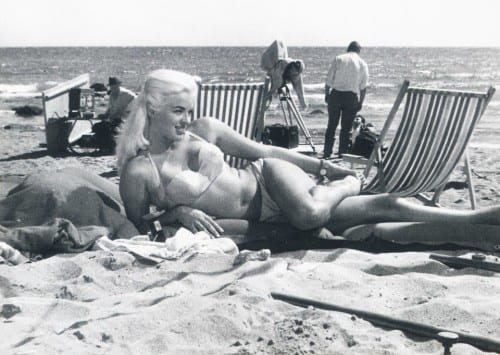WHETHER it was Diana Dors or Sean Connery, Ava Gardner or Audrey Hepburn, James Hunt or Rod Stewart, none would have come to Marbella without the influence of Prince Alfonso de Hohenlohe.
For the German aristocrat was the svengali with the necessary capital to turn the dusty village into a highfalutin millionaires playground to rival the likes of Cannes and Deauville, in France.
It was in 1947 that the charismatic playboy had been sent to the coast by his father Prince Maximilian to purchase some land. The family already had business interests in southern Spain, particularly in Malaga.
The 23-year-old was told to hook up with his eccentric uncle Ricardo Soriano, who had been eulogising about the merits of the coast for a number of years.
A huge fan of watersports, Soriano especially liked powerboat racing and lived an enviable bohemian life.
He was soon chaperoning his nephew up and down the coast in his vintage Rolls-Royce looking for land.
The bilingual Alonso – who was a keen painter – was immediately taken by what he saw in Marbella.
Sheltered by the dramatic Sierra Blanca and with crystal-clear waters just a stone’s throw away, the savvy prince immediately saw a wealth of opportunities.
He ordered his father to sell off his wine cellars in Malaga and began developing his now seminal Marbella Club hotel, which opened in 1954.
But that was not enough and the well-connected prince soon embarked on a European-wide campaign to convince all his high-flying friends that Marbella, not San Sebastian or Cannes, was the only place to be.
And his campaign worked with the grand families of central Europe, including the Bismarcks, Rothschilds and Metternichs, coming to see what the fuss was about.
A string of celebrities followed suit, with actresses including Elizabeth Taylor and Sophia Loren, photographer Patrick Lichfield, footballer George Best, model Brigitte Bardot, and Rolling Stone Bryan Jones joining the in-crowd.
Even British aristocracy got in on the act, with the Duke and Duchess of Windsor (Edward and Mrs Simpson) visiting the hotel.
“The people I met in Hollywood, in New York, and in Europe, they were the roots, the bridge that brought people to Marbella… who made Marbella,” explained Alfonso.
Marbella took pride in being cut off from the hectic, stressful and often scary modern world. Indeed, news of the Cuban Missile Crisis did not reach the resort until it was over.
“Everybody had the most gorgeous parties when the rest of the world was trembling that World War III was starting,” explains Count Rudi Schonburg, a former manager of Marbella Club.
Coining the nickname the ‘King of Clubs’, Alfonso’s reputation quickly preceded himself and he soon opened up a disco which got the club swinging every Tuesday and Friday night.
Despite revelling in its exclusive status, the Marbella Club was anything but formal.
“At dinner everybody arrived with a dinner jacket, but I said ‘Stop! This is not the Marbella way! You only wear a dinner jacket on New Year’s Eve,” recalled Alfonso.
As the inspired prince’s creation boomed, so did Marbella and its surrounding hillsides. New restaurants, bars and sports clubs began sprouting up as the Costa del Sol quickly entered its so-called golden era.
Developers included Jose Banus, who built Puerto Banus marina and King Fahd of Saudi Arabia, who built a white palace (still there today) that is modelled on both the White House and a mosque.
The likes of multi-millionaire arms dealer Adnan Khashoggi (who formerly owned La Zagaleta, Spain´s most expensive urbanisation) were able to dock their luxury yachts in the port.
“Thanks to my initiative, Marbella’s Golden Mile alone now provides 60,000 jobs,” Alfonso once said.
While his friends called him the ‘King of Clubs’ or the ‘Little Prince’, locals came to know him affectionately as Olé-Olé, because of his difficult to pronounce surname.
Yet as the Costa del Sol dream began to spiral into uncontrollable development, Alfonso became aware of the monster he had helped stir.
Concrete towers were sprouting up as far as the eye could see, from Malaga all the way down to Estepona, almost 100 kilometres away.
Worse still, wanted British criminals began to take advantage of a lack of an extradition treaty between England and Spain.
This influx of crooks and subsequent crime left the idealistic Alfonso disillusioned with the vision of rich grandeur he once envisaged for Marbella.
After growing weary of the mass tourism that was lowering the tone of his town, he sold up all his Marbella business interests in 1978 in search of a new vision.
Entering his 60s, the idealistic prince settled in his last home with his third wife Marilys Haynes, a Gibraltarian divorcee. He plumped for a mountain retreat, in the hills close to Ronda, with a trout lake, partridge wood and an impressive library.
And the ever-inventive Alfonso decided on another successful business pursuit – producing the soon-to-be award-winning wine Principe Alfonso.
And it was nestled in the heartland of Andalucia, close to the sleepy village of Arriate, where Alfonso – despite all the celebrities, parties and glamorous girlfriends – finally found true happiness before passing away, leaving his estate to his children, in 2003.
“I have lived in castles, in Venetian palaces and the world’s finest hotels. I have watched the sun rise over the beaches of five continents and I have looked into the eyes of the most beautiful women of the universe,” he famously remarked.
“Everywhere I sought my dreamed-of city and at last I have found it in Ronda.”











